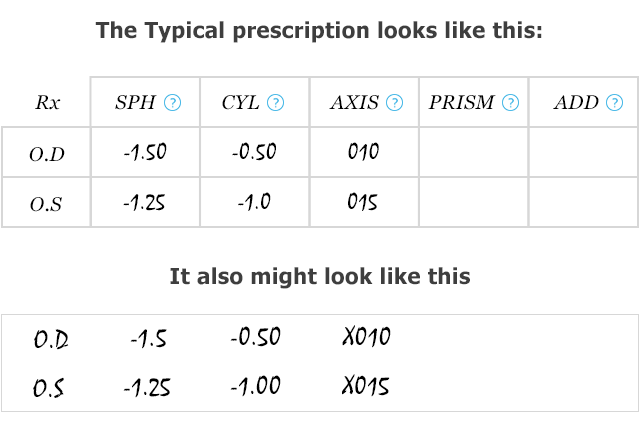- How To Order Glasses Online
- How To Find Your Frame Size
- How to Use Gift Cards
- How To Measure Your PD
- How to Adjust Your Frames at Home
- How to Buy Glasses Online With Insurance
- What Are the Different Types of Prescription Lenses
- Shipping & Returns
- Discover Our Most Popular Eyeglasses
- Discover Our Most Popular Sunglasses
- How to Buy on GlassesUSA with your Student Discount
- How to Choose Glasses for Your Face Shape
- How to Find Perfect Color for Your Glasses
- How to Choose Lenses for Your Eyeglasses
- How to Read Your Eyeglasses Prescription
- What Are Prism Glasses?
- How to Order Contact Lenses Online in 4 Easy Steps
Trying to read a prescription for glasses isn’t the easiest thing in the world, so we whipped up this guide to help you understand better what do the numbers in your eyeglasses prescription mean.
While there might be some minor variations between different eye prescription forms, the generic doctor’s RX note will probably look very much like this :

The key to reading your eyeglasses prescription, whether you have nearsightedness, farsightedness, astigmatism or anything else, is knowing what OD and OS stand for.
Sometimes appearing as O.D. and O.S. (oculus dexter and oculus sinister), which are abbreviations in Latin for right eye (OD) and left eye (OS). Some doctors may use O.U. which means both eyes, or RE and LE for right eye and left eye respectively.
There are other abbreviations in your eye prescription. Here is what each of them means:
- Sphere (SPH): Measured in diopters, the number under this header refers to the lens power necessary for each eye. A minus (-) is used to correct nearsightedness. A plus (+) sign next to the number refers to farsightedness correction.
- Cylinder (CYL): The lens power (also diopters) used to correct astigmatism. If you have no astigmatism or very slight one, nothing will appear under this column. Just like with Sphere, minus is used to indicate lens power for nearsighted astigmatism, plus is for farsighted astigmatism.
- Axis (Ax): Like Cylinder, this only applies to astigmatism prescriptions. The numbers under this column refer to angle degrees (1 to 180) and not diopters. If your prescription includes Cylinder lens power, it must include Axis as well.
- Add: Only used for multifocal (progressive/bifocal) lenses. It refers to the added magnifying power applied to the bottom of the lens in multifocal lenses. PAL is used in some cases by eye doctors when the addition for progressive lenses is different compared to bifocals.
- Prism: Prism is used to correct double vision or vision displacement. The value on the prescription refers to the number of diopters applied in order to compensate for the image alignment issues.
- PD: The distance between your pupils. If by some chance your eye doctor didn’t write it down for you in your RX note, you can easily measure it yourself.
After going online to GlassesUSA.com and choosing a frame you love, sending in your prescription is a piece of cake. You can choose one of 3 easy ways to get it done:
-
online: Copy it section by section from your doctor’s written form
-
Upload a photo: If you have a digital copy of your prescription, you can upload it directly to the site
-
Send it via email: You can complete your order without providing a prescription, instead sending it to us to us with your order number. We’ll take care of the rest!
An easy & quick way to get your prescription if you don’t need an eye exam is with our FREE Prescription Scanner app. All you need is your current glasses, a smartphone and a computer. You’ll get your optical details in a few minutes and can immediately start shopping 1000s of styles with your RX already saved on the site.
- Your eyeglasses prescription is also eligible to use for sunglasses but not with Contact Lenses.
- Your prescription is yours to keep! If you get an eye exam at the doctor’s, you don’t have to purchase your glasses there. A copy of any prescription that includes a refraction, whether multifocal prescriptions or single-vision, must be given to the patient after the exam, without charging extra.
That’s it, now you know what all the numbers in your prescription mean, and you can read it without a problem! If you already have your prescription, you can enjoy our exclusive discounts and shop a brand new RX pair right here.